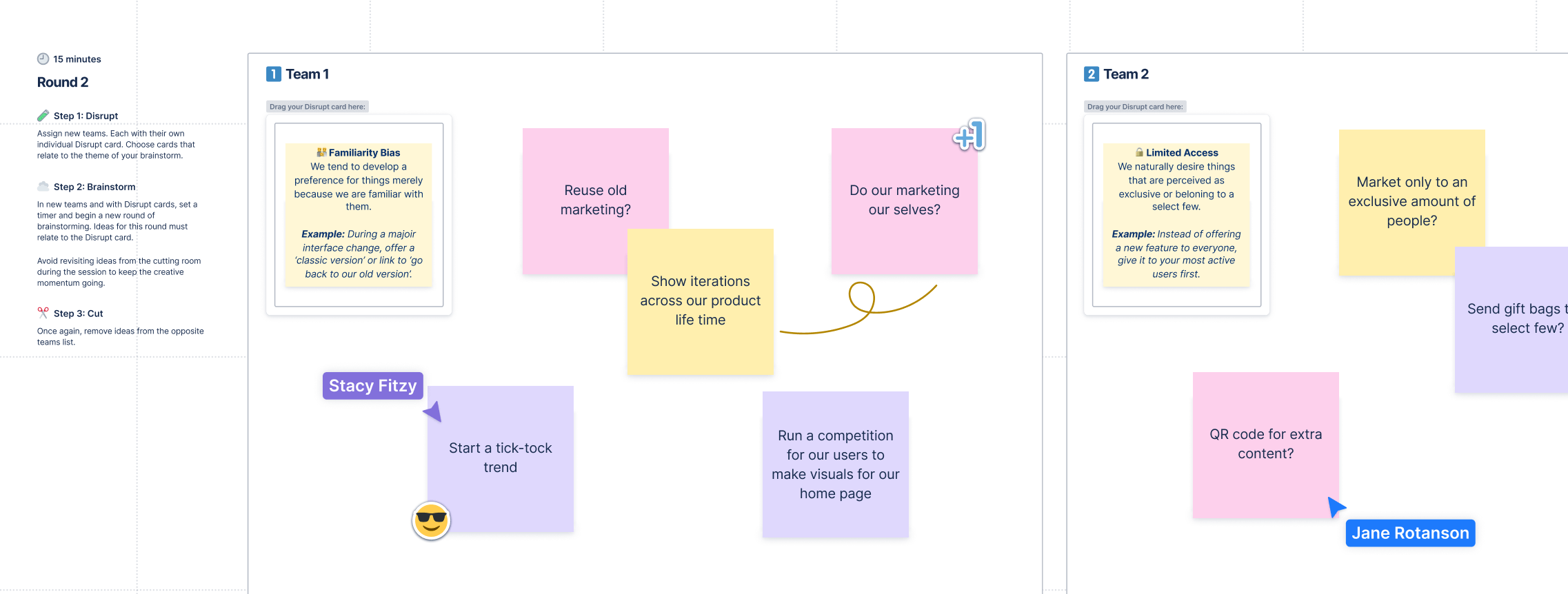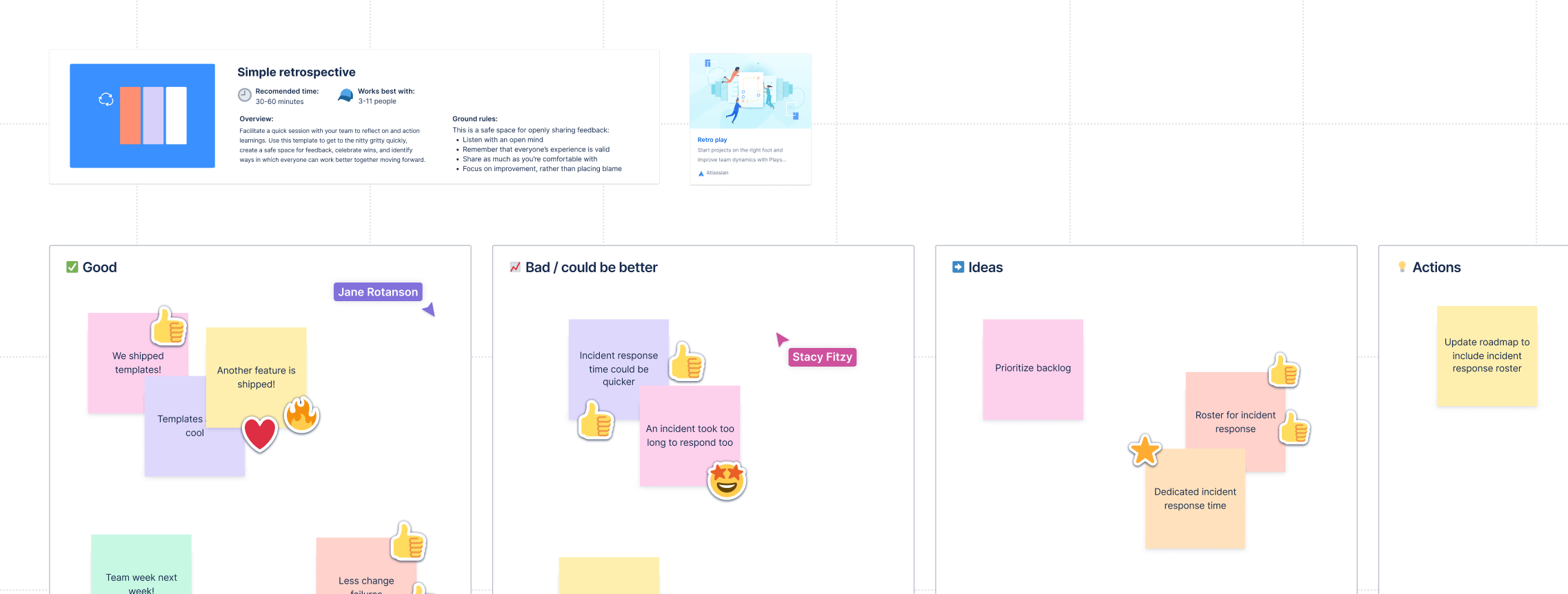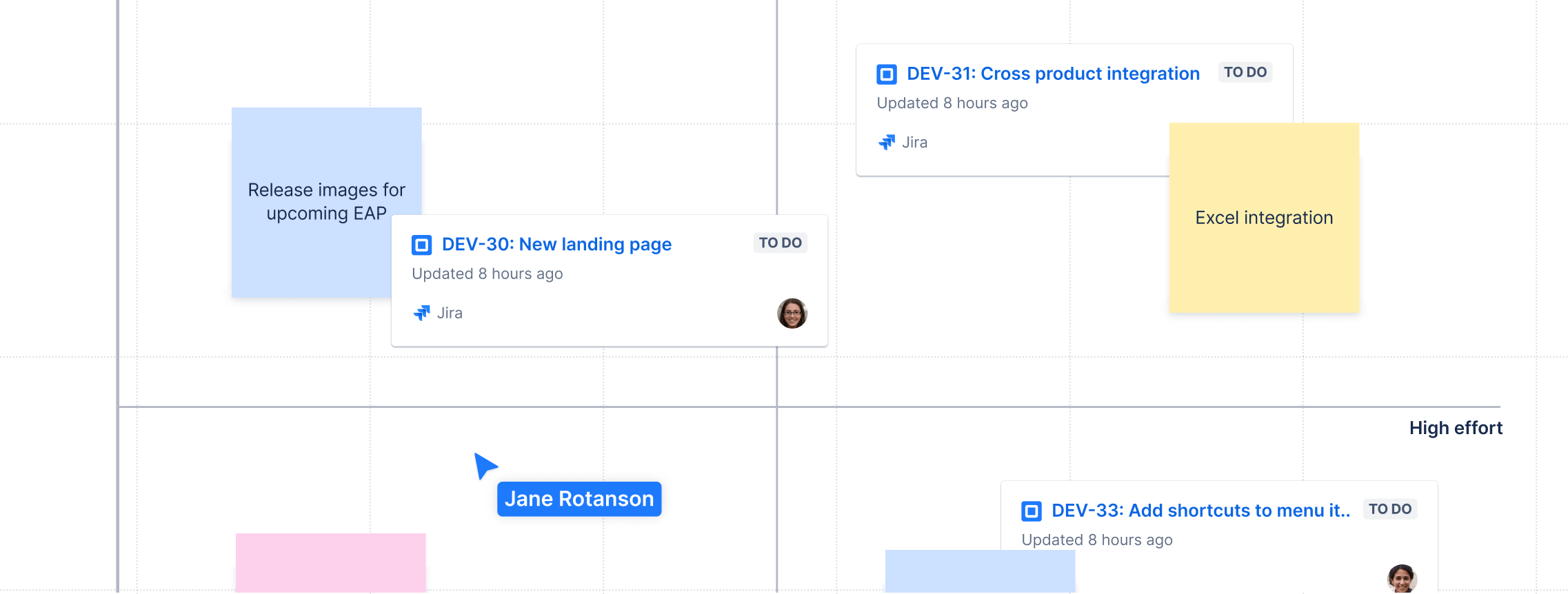Fai brainstorming con le lavagne Confluence
In grado di produrre idee brillanti
Esplora argomenti
Il metodo tradizionale di brainstorming prevede un gruppo di persone vicino a una lavagna. Il team si siede attorno a un tavolo da conferenza e propone idee a ritmo serrato.
Oggi però le sessioni con una lavagna devono essere un po' meno... analogiche. Secondo Forbes, nel 2023 il 12,7% dei dipendenti a tempo pieno lavora da casa e un altro 28,2% lavora secondo una sorta di modello ibrido.
Anche nella cultura del lavoro a distanza, il tuo team deve fare brainstorming. E tu devi comunque usare esercizi di ideazione creativa per portare avanti i progetti. Non puoi però invitare tutti nella stessa sala conferenze se alcuni dei collaboratori più importanti si trovano in fusi orari diversi.
La soluzione? Le lavagne Confluence.
Con le lavagne Confluence, avrai tutte le funzionalità di una lavagna fisica, come l'illustrazione con adesivi, il collegamento con linee, l'ideazione creativa spontanea e così via, con le capacità ampliate di una soluzione di lavoro digitale a distanza. Le lavagne Confluence si sincronizzano con Jira per offrire una collaborazione in tempo reale o asincrona tra lavoratori remoti sulla stessa board.
Hai tutte le funzioni utili di una vera lavagna con il vantaggio di unificare le sessioni di brainstorming del tuo team e sfruttare tutte le funzionalità digitali che ti vengono in mente. Ecco come funziona.
Come funziona il brainstorming su una lavagna Confluence?
Le lavagne Confluence riuniscono tutti i task e le idee di un progetto in un'unica "origine di riferimento", collegando idee, piani e task in un hub centralizzato in formato lavagna. Hai quindi tutti i vantaggi di una lavagna senza la lavagna fisica.

Non dovrai più cambiare scheda, dispositivo o computer, districandoti tra soluzioni software con troppi login e nomi utente che mandano in confusione. Confluence si sincronizza con Jira, il nostro software di monitoraggio dei ticket, per garantire che ogni lavagna non sia solo un posto dove lasciare le proprie idee. La tua lavagna sarà un vero e proprio strumento di gestione dei progetti in tempo reale, che ti consente di organizzare lo svolgimento del lavoro.
Quando usi le lavagne Confluence, hai alcuni vantaggi immediati per la gestione dei progetti:
- Un'unica origine di riferimento che collega idee, task e flussi di lavoro in un unico hub centralizzato, visibile a tutti i membri del tuo team. Così la collaborazione diventa anche visiva e i membri del tuo team possono aggiungere contesto direttamente alla board tramite allegati.
- L'accesso per l'intero team rende trasparente ogni progetto e consente alle persone di inviare le proprie idee per le sessioni di brainstorming.
- Hai anche un risparmio immediato sui costi grazie al consolidamento degli strumenti. Se ti sei registrato a Confluence, puoi già usare le lavagne Confluence.
-
La collaborazione virtuale viene ottimizzata e questo ha un grande impatto su tutta l'organizzazione. Con le lavagne Confluence, ogni lavoratore è coinvolto in riunioni critiche di brainstorming o nei dati del flusso di lavoro e può capire qual è il senso di ogni progetto nel piano generale. Puoi anche usare Confluence per garantire l'accesso alla lavagna a livello di team, semplificando gli aggiornamenti.
Come usare Confluence per un brainstorming efficace
OK: ti abbiamo detto che con Confluence hai ogni genere di funzione nella tua lavagna. Le lavagne comportano però anche un aspetto intangibile, ossia la creatività, che scorre nella sala conferenze come il caffè.
Una lavagna, infatti, non serve soltanto alla pianificazione di un flusso di lavoro. Una sessione di brainstorming efficace può aiutarti a risolvere i problemi facendo domande più pertinenti.
Come osserva l'Harvard Business Review, il movimento della psicologia positiva è nato durante una sessione di brainstorming. Il brainstorming ha portato i partecipanti a porsi una domanda diversa: anziché valutare la salute psicologica in base all'assenza di condizioni negative, perché non domandarsi se le condizioni positive promuovono il benessere?
Un'ideazione creativa del genere può cambiare tutto in una frazione di secondo. La spontaneità è essenziale: bisogna fare le domande che nessuno ha mai posto prima.
In che modo questo influisce sulle lavagne e sugli esercizi di ideazione creativa di Confluence? Esploriamo le funzionalità.
Usare le lavagne di Confluence per strutturare e organizzare le idee
Le sessioni sulla lavagna sono sicuramente importanti momenti creativi. Una sessione di brainstorming lascia spazio al tuo team dando la libertà necessaria per far emergere le idee senza il timore di ricevere un rifiuto.
Ma gli esercizi di ideazione creativa non sono l'unica cosa che puoi fare con le lavagne. Esse, infatti, sono ottime per strutturare una raccolta di idee sparse in una campagna, un progetto o una nuova iniziativa.
Il problema con le lavagne tradizionali è che richiedono molte operazioni di cancellazione, modifica e scambi redazionali. Le lavagne di Confluence, invece, offrono una sorta di assistenza digitale quando si tratta di organizzare le idee.
- Puoi illustrare la relazione tra le idee con note adesive, linee e sezioni, proprio come faresti se ti trovassi davanti a una lavagna con un pennarello in mano
Inizia ad assegnare task e sottotask di Jira ai singoli membri del team in modo da uscire da una sessione di brainstorming con più di semplici idee: ottieni una lista di cose da fare per il team
Creare modelli e pagine dedicate per esercizi di brainstorming e ideazione creativa
Una lavagna fisica è proprio questo: una lavagna con molto spazio bianco. Le lavagne di Confluence, invece, possono essere precompilate con modelli di best practice, dandoti l'input per qualsiasi sessione di brainstorming:
- I modelli di brainstorming si riempiranno di note per dare il via a quelle rivoluzionarie domande «e se...?».
- I modelli retrospettivi ti aiutano a condurre interviste di uscita su vecchi progetti: i buoni, i cattivi e i brutti.
- Le matrici di prioritizzazione dividono la lavagna in una griglia in modo da poter organizzare le decisioni che il tuo team sta affrontando (assegnando anche le priorità).
- Le guide alla formazione dei team sono ottime per assegnare gli utenti a progetti specifici all'interno dell'organizzazione, il che può portare a sessioni di brainstorming separate tramite Confluence.
- Le mappe concettuali possono essere fondamentali per mappare le risorse del team, i flussi di lavoro e programmare più progetti contemporaneamente.
Passando a una lavagna digitale non perderai alcuna funzionalità. Note adesive? Puoi usarle. Timbri? Usali per reagire e votare le tue idee preferite. Tutto ciò che puoi fare con una lavagna fisica, puoi farlo anche con una lavagna di Confluence, indipendentemente da dove si trovano le persone e con facilità. Sarà come se foste tutti nella stessa stanza.

Sincronizza l'ispirazione di un team da un'unica origine di riferimento
Collaborazione a livello aziendale: è questo l'obiettivo da raggiungere. Se non puoi avere tutto il team nella stanza con una sola lavagna, potresti pensare di aver escluso membri essenziali del team. Il risultato: non ricevi l'ispirazione da più angolazioni e background facendo domande chiave durante una sessione di brainstorming.
Con Confluence, però, tutto cambia. Puoi sincronizzare automaticamente i nuovi aggiornamenti alla tua home page di Confluence o aggiungere aggiornamenti specifici del progetto a una lavagna di Confluence. Stiamo programmando anche l'introduzione di funzionalità come le menzioni «@» per garantire che le conversazioni tra colleghi siano facili da consultare e reindirizzare.
In una lavagna tradizionale, potrebbero essere necessari minuti per completare un'azione. Con le lavagne di Confluence, puoi avere una sessione di brainstorming virtuale e procedere nei vari fusi orari senza perderti nulla.
C'è anche una funzionalità interessante che consente l'integrazione di queste lavagne con Jira.
Puoi usare le lavagne di Confluence per raggruppare una serie specifica di task, idee o incarichi. Le sezioni intelligenti assicurano che tu non debba aggiornare i ticket di Jira dopo aver programmato le sessioni. Tu e il tuo team potete portare avanti il lavoro senza dover tornare indietro e rivederlo in Jira. In sostanza, puoi configurare sezioni con azioni Jira configurate, che poi vengono applicate a tutti i ticket Jira correnti nelle sezioni. Usa questa funzione per aggiornare in blocco i campi, come priorità, assegnatario, Story Point e altro.
E funziona anche in due modi. I membri del team possono caricare le loro note o i loro link web sulla lavagna in modo che tutti possano farvi riferimento. Il risultato: le tue sessioni di brainstorming virtuali si trasformano senza problemi in un elenco di cose da fare, proprio come uno strumento di gestione dei progetti.
Incorporare immagini e link per illustrare le idee e renderle più coinvolgenti
A un certo punto, la lavagna «analogica» non è più sufficiente per tutto quello che vuoi fare. Su una lavagna puoi incollare note adesive e, magari, stampare un'immagine e fissarla con del nastro adesivo. Ma quando avrai un progetto che include video, webinar e teleconferenze, nessuna lavagna sarà d'aiuto.
Beh, una c'è.
La lavagna di Confluence può incorporare immagini per illustrare le idee. Piuttosto che una lavagna piena di lunghe righe di testo, le immagini possono far passare le idee molto più rapidamente. Ciò è particolarmente rilevante per i progetti visivi e basati sul design.
Se stai creando una lavagna, puoi usare questa funzionalità anche per assegnare task ai membri del team. Puoi evidenziare le sessioni di brainstorming virtuali in modo che un copywriter sappia di cosa scrivere. Puoi registrarti mentre dai note dal vivo per fornire feedback a un designer. Oppure puoi semplicemente incollare il link di un video che hai visto online, fornendo contesto e background aggiuntivi ai membri del team che ne hanno bisogno.
Avviare sessioni di collaborazione sulla lavagna per team remoti
Alcune funzionalità delle lavagne di Confluence possono aiutare i membri del team che lavorano da remoto a tenere il passo, anche se non sono stati inseriti nella sessione iniziale della lavagna. Ma non abbiamo ancora chiarito quanto possa essere collaborativo questo processo.
Con una lavagna di Confluence, le tue sessioni non si limitano a chi è nella stanza. Puoi creare una sessione online, sul computer o dal vivo in una sala conferenze, e coinvolgere tutti i membri del team remoto. Non devi abbandonare a sé stessi i membri del team in tutto il mondo e aspettare che recuperino il ritardo. E non devi nemmeno lasciarti sfuggire le loro reazioni o i loro approfondimenti spontanei.
Non dimenticare l'importanza scientifica dello stato del flusso. La spontaneità e le reazioni dal vivo sono importanti per la creatività. Come è stato osservato in uno studio, «la possibilità di sorprendere» è un ingrediente essenziale del flusso. Nelle sessioni di brainstorming, quando emerge una buona idea, questa stimola istantaneamente quel senso di fluidità.
Questo è un effetto che non puoi catturare così facilmente via email. Servono interazioni dal vivo e reazioni spontanee per generare quel flusso creativo, che alla fine porta a idee migliori sulla tua lavagna.
Brainstorming e programmazione dei progetti senza uscire da Jira
Se usi già Jira, conosci quanto sia utile offrire al tuo team un'unica origine di riferimento per ogni progetto. Dal tracciamento dei bug agli strumenti di gestione dei progetti Kanban, Jira ha tutto ciò di cui hai bisogno per creare flussi di lavoro che mantengano il business attivo.
Tuttavia, spostare le sessioni di brainstorming su Confluence potrebbe sembrare difficile. Aggiungere Confluence non significa ulteriori complicazioni inutili?
No, considerato come funzionano le lavagne di Confluence. Confluence riunisce tutto il tuo lavoro in un'unica visualizzazione. Puoi ancora usare Jira come hai sempre fatto; in effetti, ci sono modi per migliorare il modo in cui usi Jira:
- Converti memo e forme in ticket di Jira. Un memo sulla lavagna è un modo pratico per annotare qualcosa di breve. Con le lavagne di Confluence, il memo è qualcosa di più di un semplice promemoria. Puoi convertire i memo in "ticket" di Jira e questo aiuta a gestire Jira senza uscire dalla lavagna.
- Collega i ticket di Jira per mappare il tuo lavoro. E se hai più ticket di Jira e hai bisogno di vedere come fluiscono insieme? Puoi anche collegarli all'interno della lavagna di Confluence. Oppure puoi importare i ticket di Jira per visualizzare i tuoi task. A volte, ciò significa compilare una lavagna con il lavoro di programmazione premappato già svolto.
- Modifica i ticket di Jira insieme alle pagine di Confluence, ancora una volta senza mai dover uscire dalla lavagna.

Oltre a queste funzionalità, puoi incorporare programmi e aggiungere link come necessario. È difficile incollare un PDF su una vera lavagna. Ma con le lavagne di Confluence, puoi avere un'esperienza completamente digitale a cui possono accedere tutti i membri del team remoto.
Promuovere l'ideazione creativa e l'innovazione con le lavagne di Confluence
È tutto pronto per portare la tua lavagna nella generazione della collaborazione digitale e del consolidamento degli strumenti? Non limitarti a fare del semplice brainstorming; fai il brainstorming con uno strumento che possa aiutarti a trasformare ogni idea in qualcosa di più di un'idea. Concludi con un solido sistema di gestione dei progetti che farà avanzare il progetto, terrà il team impegnato e i lavoratori da remoto connessi.

